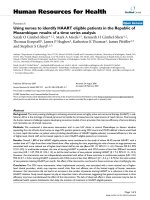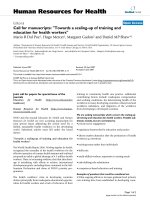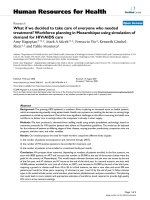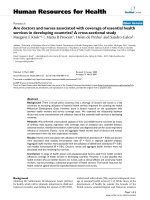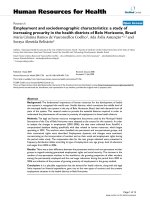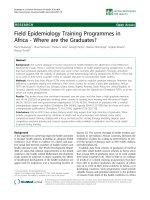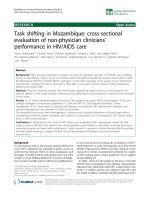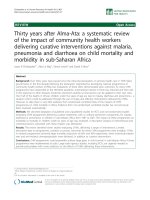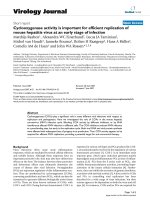báo cáo sinh học:" Thirty years after Alma-Ata: a systematic review of the impact of community health workers delivering curative interventions against malaria, pneumonia and diarrhoea on child mortality and morbidity in sub-Saharan Africa" docx
Bạn đang xem bản rút gọn của tài liệu. Xem và tải ngay bản đầy đủ của tài liệu tại đây (337.17 KB, 11 trang )
REVIEW Open Access
Thirty years after Alma-Ata: a systematic review
of the impact of community health workers
delivering curative interventions against malaria,
pneumonia and diarrhoea on child mortality and
morbidity in sub-Saharan Africa
Jason B Christopher
1*
, Alex Le May
1
, Simon Lewin
2
and David A Ross
3
Abstract
Background: Over thirty years have passed since the Alma-Ata Declaration on primary health care in 1978. Many
governments in the first decade following the declaration responded by developing national programmes of
community health workers (CHWs), but evaluations of these often demonstrated poor outcomes. As many CHW
programmes have responded to the HIV/AIDS pandemic, international interes t in them has returned and their role
in the response to other diseases should be examined carefully so that lessons can be applied to their new roles.
Over half of the deaths in African children under five years of age are due to malaria, diarrhoea and pneumonia - a
situation which could be addressed through the use of cheap and effective interventions delivered by CHWs.
However, to date there is very little evidence from randomised controlled trials of the impacts of CHW
programmes on child mortality in Africa. Evidence from non-randomised controlled studies has not previously
been revi ewed systematically.
Methods: We searched databases of published and unpublished studies for RCTs and non-randomised studies
evaluating CHW programmes delivering curative treatments, with or without preventive components, for malaria,
diarrhoea or pneumonia, in children in sub-Saharan Africa from 1987 to 2007. The impact of these programmes on
morbidity or mortality in children under six years of age was reviewed. A descriptive analysis of interventional and
contextual factors associated with these impacts was attempted.
Results: The review identified seven studies evaluating CHWs, delivering a range of interventio ns. Limited
descriptive data on programmes, contexts or process outcomes for these CHW programmes were available. CHWs
in national programmes achieved large mortality reductions of 63% and 36% respectively, when insecticide-treated
nets and anti-malarial chemoprophylaxis were delivered, in addition to curative interventions.
Conclusions: CHW programmes could potentially achieve large gains in child survival in sub-Saharan Africa if these
programmes were implemented at scale. Large-scale rigorous studies, including RCTs, are urgently needed to
provide policymakers with more evidence on the effects of CHWs delivering these interventions.
* Correspondence:
1
PHDC Masters Programme, London School of Hygiene & Tropical Medicine,
UK
Full list of author information is available at the end of the article
Christopher et al. Human Resources for Health 2011, 9 :27
/>© 2011 Christopher et al; licensee BioMed Central Ltd. This is an Open Access article dist ributed under the t erms of the Creative
Commons Attribution License (http://creativ ecommons.org/licenses/by/2.0), which permits unrestricte d use, distribution, and
reproduction in any medium, provided the original work is proper ly cited.
Background
In 1978, the Declaration of Alma-Ata presented Primary
Health Care (PHC) as the means of achieving Health for
All and community or lay health workers (CHWs)
became a distinguishing feature of PHC implementation
as it w as rolled o ut. Several reviews of national CHW
programmes in the late 1980s and early 1990s came to
similar conclusions: quality of care from large-scale pro-
grammes was poor, generally because of a lack of
ongoing training and supervision and poor logistical and
financial support [1-3]. It has bee n argued that w here
national CHW programmes have failed, this has not
been due to a failure of the concept of CHWs or PHC
but because the support and supervision necessary to
make them effective were too often missing. With the
HIV/AIDS pandemic, and increasing ac knowledgeme nt
of the critical shortage of human resources within health
services to respond to it and to other diseases, the
potential roles of CHWs within PHC have received
renewed attention [4]. Recent developments confirm the
growing recognition of the importance of PHC. It was
the main subject of the 2008 WHO World Hea lth
Report, has the endorsement of WHO Director-General
Margaret Chan [5], and was the topic of a themed issue
of the Lancet [6].
Sub-Saharan Africa has only 3% of the global health
workforce [7] but accounts for almost half o f the 7.7
million child deaths globally [8,9]. 55% of these deaths
in African children under 5 years of age are caused by
malaria, pneumonia and diarrhoea [10]. Inexpensive
interventions such as antibiotics, oral rehydration solu-
tion, insecticide-treated nets (ITNs) and antimalarials
have been proven effective against these diseases, and it
has been estimated that 65-91% of childhood deaths
from these three diseases could be prevented if such
interventions were delivered at scale in low-income
countries [11]. Given the very limited professional health
care human resources in these settings, it is important
to examine the evidence for the effectiveness of CHW
programmes as a delivery strategy for such interventions
in sub-Saharan Africa. Whilst CHWs may deliver both
preventive and curative interventions, this review
focuses on the impact CHWs have when delivering
curative interventions. The training and roles of CHWs
who do not have any responsibility for the treatment of
sick children are likely to be quite different from CHWs
delivering curative interventions, and for this reason the
review did not include the former.
Five recent reviews have examined CHW programmes.
Lewin et al. [4] and Haines et al. [12], for example, con-
ducted systematic and non-systematic reviews, respec-
tively, that were broad in scope and were restricted to
RCTs. The reviews identified only three assessments of
CHWs’ effectiveness from sub-Saharan Africa. A non-
systematic review by Lehmann and Sanders [13]
reported a broad range of evidence on CHWs. Beyond
the th ree studies identified by Lewin et al. [4] they iden-
tified no further data on the impact of CHW pro-
grammes on morbidity/mortality in sub-Saharan Africa.
Winch and colleagues [14] described the main models
of CHW programmes addressing malaria and pneumo-
nia in terms of drug delivery but did not assess their
effectiveness. Finally, a recently published systematic
review calculated a mortality impact estimate for inter-
ventions delivered by CHWs to preschool child ren [15].
However, only interventions against pneumonia were
included in this research, and only one of the seven con-
tributing studies was from Africa.
These reviews indicate that randomised controlled
trial (RCT) evidence on the effectiveness of CHW pro-
grammes in sub-Saharan Africa is extremely scarce.
While reviews have stressed the need for further health
impact rese arch, they have not considered the available
evidence from non-randomised studies. This review
attempts to rectify this by systematically re viewing ran-
dom ised and non-randomised studies of CHWs’ impact
on child mortality in sub-Saharan Africa. The weak-
nesses of non-randomised studies hav e been described
[16]. However, exclusion of all such studies without
further consideration effect ivel y places a zero weighting
on evidence from non-randomised studies, which is
clearly inappropriate. As long as the weaknesses of non-
randomised studies are elucidated and taken into
account, it is appropriate to evaluate the evidence from
them, especially where RCTs are absent or few, in order
to provide useful advice to policymakers on the impact
of interventions[17,18].
This p aper reports how we conducted the systematic
review, an analysis of the studies identified by the review
with descriptions of the CHW programmes they evalu-
ated, and the observations and conclusions we have
made.
Methods
Search strategy
Systematic reviews a re summaries of research evidence
that address a clearly formulated question using sys-
tematic and e xplicit methods to identify, select, and cri-
tically appraise relevant research, and to collect and
analyse data from the studies that are included in the
rev iew [19]. For this systematic review, we searc hed the
Medline (OVID), Embase (OVID) and CAB Direct data-
bases, the last of which includes unpublished literature.
CHW search terms from Lewin and colleagues’
Cochrane review [4] were used, with permission. The
search was limited to studies with a sub-Saharan African
medical subject hea ding (MeSH) te rm, involving inter-
ventions directed, at least in part, at children less than
Christopher et al. Human Resources for Health 2011, 9 :27
/>Page 2 of 11
six years of age, and that were delivered by CHWs who
provided treatment (w ith or without preventive services)
for malaria, diarrhoea or pneumonia. Searches were not
limited by language. The disease-specific search filters
were drawn from those used in the Medline (OVID)
searches for the Cochrane systematic reviews of pneu-
monia [20], diarrhoe a [2 1] and malar ia [22]. The corre-
sponding Embase MeSH terms and CAB Direct
keyword searches were substituted for those used in the
Medline(OVID) search. All the same limits and free-text
searches were used (see Additional File 1).
All three database searches were developed iteratively.
The titles and abstracts of the first 20 identified studies per
database were analysed for additional r elevant terms. Those
not already within the respective database search were
added to inc rease the search sensitivity. Titles an d abstracts
were studied for relevance. Full-text articles were located
for those studies determined as potentially meeting the
inclusion criteria. Tw o researchers with an interest in CHW
programmes and child mortality were contacted to see if
they knew of any additional unpublished or published data.
We also examined the bibliographies of all full-text papers
for further potential studies. Emails were sent to the authors
of all included studies requesting details of any additional
studies and t o ask for further i nformation on the character-
istics of the CHW programme they had evaluated. Three
landmark books on CHWs published between 1987 and
2007 were also examined for e ligible studies [1-3].
Definitions and inclusion criteria
Study Design
Randomised contro lled trials (RCTs), controlled b efore
and after (CBA), uncontrolled before and after, inter-
rupted time series, and cohort and case control studies
were included. Cross-sectional studies were excluded.
We assessed risk of bias for included studies but did not
exclude studies on this basis.
Study participants
A range of cadres with varied training and performing
different roles have come under the umbrella term of
CHW and it is thus difficult to provide a precise defini -
tion. For this review, we defined CHWs as individuals
trained in the particular role of de livering curative care
(with or without preventive health interventions) for
malaria, pneumonia or diarrhoea to children aged less
than six years. The intention was to evaluate C HWs
who improve access to this curative care by working in
community settings. However, in their liaison with other
health workers, CHWs may spend some time in health
centres. We did not want to exclude such CHWs from
the review and therefore an additional c riterion for
inclusion was that CHWs work ed, at least in part, out-
side medical facilities. Excluded from our definition
were health workers who had received formal health
training, apart from CHW training, and those who were
formally accredited to a health worker cadre, such as
nurses, paramedics or clinical officers. Teachers provid-
ing school-based activities would only have been
included if they provided curative care to children aged
less than six years. M others who had been trained to
give anti-malarials from a pack to their own child were
also excluded because they were not responsible for pro-
viding treatment outside their own families. Included
studies were those that had evaluated the impact of
interventions directed at children less than six years of
age or where the impact in this age group (or part of
this age group) was reported separately.
Interventions
We included CHWs delivering curative care , with or
without preventive services, to children for at least one
of malaria , pneumonia and diarrhoea. Programmes deli-
vering purely preventive interventions (e.g. bed-net dis-
tribution and community-based hygiene education
programmes) were excluded.
Effectiveness outcomes
Studieswereincludediftheyprovideddataonthe
impact of the CHW programme o n mortality, morbidity
or nutritional status in children under six years of age.
Region and time
We included studie s conducted in sub-Saharan Africa
between 1987 a nd 2007. This 20-year time-span w as
chosen because it covers the period following the three
major earlier assessments of African CHW programmes
[1-3]. We considered it unlike ly that there were many
eligible studie s preceding this d ate and were concerned
about changes in treatment delivery since the early
1980s.
Two reviewers (JC, AL) independently assessed all the
titl es and abstracts arising from the literature search for
inclusion. A third reviewer (SL) was available as an inde-
pendent arbiter when needed.
Data extraction
Data extraction, and an assessment of risk of bias, was
conducted independently by two reviewers using a com-
mon, pre-defined reporting matrix to summarise find-
ings (see Additional file 2). Earlier evaluations of CHW
programmes [1-3] identified important c ontextual and
interventional determinants of effective CHW pro-
grammes (see ‘Data Extraction: Characteristics which
determine the effectiveness of CHW Programmes’ sec-
tion). Where possible this information was also
extracted from study papers, references nd information
obtained from the original authors.
Assessment of risk of bias
Randomised Controlled Trials: RCTs were assessed with
regard to attrition, performance and detection biases,
Christopher et al. Human Resources for Health 2011, 9 :27
/>Page 3 of 11
concealment of allocation, use of intention-to-trea t ana-
lyses and risk of contamination. Non-Randomised Stu-
dies : Data on potential confounders ( see ‘Data extracted
on potential confounder’ section) were extracted from
articles, references and author-provided information in
order to determine whether intervention and control
groups were differentially affected. Risk of selection bias
was assessed using the TREND checklist for the report-
ing of non-randomised studies [23].
Data Extraction: Characteristics which determine the
effectiveness of CHW Programmes
CONTEXTUAL FACTORS
Setting
Country, Rural/Urban
Healthcare setting: Home/Other
Context
Burden of malaria/diarrhoea/acute respiratory
infection
Population characteristics (demography, sex, socio-
economic status, cultural & religious background)
Functioning of basic health services
Decentralisation of health service control
Employment alternatives for CHWs
INTERVENTION FACTORS
CHW Programme Overview
Start date
Who s et up & managed the programme(e.g. National
Programme v NGO)
Number of CHWs in the programme
Number of total programme beneficiaries
Attrition rate of CHWs (i.e. how many of them stop
being CHWs over time)
Paid or not, and if so by whom and how (e.g. cash or
in kind)
CHW Roles
Curative & preventive health activities
Weekly pattern of activity
CHW Selection
By whom they were selected and the criteria used
CHW Characteristics
Education, sex, age, marital status, ethnicity, religion.
CHW Training
Duration, methods of training (e.g. didactic/practical),
site (e.g. is it near their setting of work?), choice of
trainers
Content of training (e.g. curative v prevent ive, record-
keeping, training/education skills)
Refresher courses (how often, how long and by whom)
CHW Supervision
Who supervises? (eg villagers, PHC worker,
government)
How do they supervise?
Existence of incentives for work of quality.
Data extracted on potential confounders
➣ Alternative public/private health care provision
➣ NGO/mission healthcare provision
➣ Economic factors (e.g. improved economic status
permitting better transport)
➣ Geographical factors (e.g. roads improving access
to healthcare)
➣ Environmental factors (e.g. rains, famine)
Analysis
Statistical pooling of outcome data was not attempted
as the heterogeneity of the studies with regard to con-
textual and interventional factors would have ren-
dered such a meta-analysis potentially misleading.
Instead a narrative description of the results was
conducted.
Results
The searches identified 499 unique titles and abstracts
(see Figure 1). Screening of titles and abstracts revealed
25 titles that potentially met the inclusion criteria and
full-text articles of these were obtained. Seven studies,
published between 1991 and 2005, met the review’ s
inclusion criteria.
Description of included studies
The key characteristics of the stud ies are summarised in
Table 1. For reporting here, each CHW programme has
been given a short name, as outlined in Table 1.
Study settings
All seven CHW programmes were conducted in West
Africa. Four studies evaluated CHWs in the Gambia
[24-27]. Three of these studies [24-26] tested CHW pro-
grammes in the population of Farafenni, North Division.
Menon and colleagues [24] and Greenwood and collea-
gues [26] studied CHWs delivering identical services in
thesamepopulationanddifferingonlywithregardto
when impact was assessed. Two studies assessed CHW
programmes in Ghana [28,29] and one evaluated CHWs
in Benin [30]. All studies were located in rural settings
with high mortality and morbidity from diarrhoea, pneu-
monia and malaria.
Study designs and outcomes
One study conducted in Ghana was an RCT [28] and
four others we re CBA stud ies, all based in the Gamb ia
[24-27]. Also included were one uncontrolled before
and after comparison [29] and one case-c ontrol study
[30]. All studies measured impacts on infant and c hild
mortality through the use of demographic surveillance
systems. Malarial morbidity was also assessed in the
Gambian studies.
Christopher et al. Human Resources for Health 2011, 9 :27
/>Page 4 of 11
Characteristics of CHW programmes
The Gambian PHC programme and the Pahou p ro-
gramme in Benin were nationwide CHW interventions
from which a selected group of CHWs were studied
[27,30]. The Navrongo and Gomoa studies in Ghana
were of small-scale CHW programmes initiated by
research institutes at the time of the study [28,29]. The
number of CHWs included in the studies ranged from
8 to 17. In the Gambian PHC and Navron go projects,
the CHWs were older men selected by village health
committees [27,28]. The sex and selection of CHWs in
the Gomoa and Pahou (Benin) projects were not
reported.
Apart from the Gomoa project which did not report
this information [29], all CHW programmes delivered
health education on childhood nutrition, hygiene and
immunisations, oral rehydration solution and dispensed
chloroquine as anti-malarial chemotherapy as w ell as
other unspecified medicines. Some CHW programmes
provided paracetamol, mebenda zole and multivitamin s
as well as growth monitoring. Pahou CHWs made refer-
rals of patients to community health centres [30] but no
mention was made of such a role in the other pro-
grammes. Gambian PHC was the only programme in
which CHWs provided antibiotics (Penicillin V injec-
tions). Of the Gambian PHC programmes, Menon and
colleagues [24] and Gr eenwood and colleagues [26] stu-
died CHWs delivering maloprim for malarial chemopro-
phylaxis whilst Alonso and colleagues [27] studied
CHWs delivering insecticide-treated nets (ITNs).
Navrongo CHWs were trained for 6 weeks [28] and
Gambian PHC CHWs for 8 weeks [27]. The duration
of training was not reported for the Pahou and Gomoa
programmes. Little information was provided about
the nature of this training or on the availability of
further education after the initial cou rse. CHW pay-
ment was noted to be informal and left to the discre-
tion of the villagers in the Gambian PHC programme,
and unreported for the ot her programmes, except for
Navrongo where CHW work was clearly stated to be
unpaid [28]. CHWs were supervised by a range of pro-
fessionals, including community health nurses in
Pahou and Gambian PHC [27,30], physicians and
nurses in Gomoa [29] and by a village health commit-
teeintheNavrongoprogramme[28].Theservices
available to the comparison groups in the studies were
poorly described. The Gambian national PHC pro-
gramme only placed CHWs in villages with over 400
residents, and smaller villages were used as controls.
Mobile teams delivering the Expanded Programme on
Immunisation visited both the larger and smaller vil-
lages. The control group i n the Navrongo study [28]
Figure 1 Literature search chart. CBA: Controlled before and after study.
Christopher et al. Human Resources for Health 2011, 9 :27
/>Page 5 of 11
received rural healthcare according to Ministry of
Health guidelines. The other studies gave no descrip-
tions of services for comparison groups.
Risk of bias
The Navrongo study [28], using a cluster RCT design,
randomised each of 4 clusters to receive a different
health care delivery strategy, one of which was a control.
Comparability of the c lusters was compromised by dif-
fering baseline child mortality rates, and the fact that
there was only one cluster in each study arm will have
negated m any of the potential advantages of randomisa-
tion [31]. The intervention was scaled up incrementally
within each cluster. A comparison was made of the
mortality rates between geographical areas where the
intervention had and had not been scaled up. However,
the process by which geographical areas within a cluster
were chosen for initial scale up was no t described and
therefore the comparison of these areas may have been
affected by selection bias.
Hill and colleagues [25], in reporting the findings of
their CBA study in the Gambia, noted that better roads
were built near the villages in the intervention group
(PHC villages). This co-intervention, which took place
during the study period, may have confounded the study
findings since improved access to facility care for PHC
villages relativ e to non-PHC (co ntrol) villages may have
been responsible for the reduction in mortality observed
following the intervention. No mortality reduction was
evident before the roads were built [25].
Table 1 Characteristics and Findings of Studies
Study
(first author,
publication
date,
reference)
Setting CHW
programme
Intervention tested Study
design
Period when impact
measured
Change in
mortality (95% CIs)
Change in
morbidity
(95% CIs)
Gambian
PHC
(Greenwood,
1988, [26])
North
bank of
river,
Gambia.
Rural
National
programme
(all villages
> 400
people have
a CHW)
13 CHWs delivering curative
treatments, health education &
malaria chemoprophylaxis
CBA 9-21 months after CHWs
began delivering anti-
malarial
chemoprophylaxis
36% (-17, 63)
reduction 1-4 yr old
mortality
84% (48, 95)
reduction in
fever and
parasitaemia
Gambian
PHC
(Menon,
1990, [24])
North
bank of
river,
Gambia.
Rural
National
programme
(as above)
13 CHWs delivering curative
treatments, health education &
malaria chemoprophylaxis
CBA 3-4 yrs after CHWs
began delivering anti-
malarial
chemoprophylaxis
77% (51, 89)
reduction in 1-4 yr
old mortality
84% (60, 94)
reduction in
fever and
parasitaemia
Gambian
PHC
(Hill, 2000,
[25])
North
bank of
River
Gambia.
Rural
National
programme
(as above)
1 CHW & TBA per village (15
villages) Curative treatments &
health education delivered.
CBA Mortality measured in
four successive 2-3 yr
periods after programme
onset in 1983, covering
14 years.
33% (10, 50)
reduction in 1-4 yr
old mortality, 6 to 9
yrs after programme
onset.
Not
assessed
Gambian
PHC
(Alonso,
1991, [27])
South
bank of
river,
Gambia.
Rural
National
programme
(as above)
1 CHW & TBA per village (17
villages) delivering ITNs, curative
treatments & health education
CBA 0-12 months following
initiation of ITN delivery
by CHWs
63% (32, 80)
reduction in 1-4 yr
old mortality
Not
assessed
Navrongo
(Pence, 2005,
[28])
North
Ghana.
Rural
Initiated by
research
institute
CHWs
delivering health education,
curative treatments, making
referrals
Cluster
RCT
Only 4
clusters
4-5 years after CHWs
rolled out
87% (27, 178)
increase in 1-2 yr old
mortality
Not
assessed
Gomoa
(Afari, 1995,
[29])
South
Ghana.
Rural
Initiated by
research
institute
Curative treatments & growth
monitoring by 6 CHWs, 1 nurse &
1 physician.
Before
and
after
study
0-3 years after
programme onset.
61% (no CIs given)
reduction in 0-4 yr
old mortality, 36
months after
programme onset
Not
assessed
Pahou
(Velema,
1991, [30])
Coast
of
Benin.
Rural
National
programme
17 CHWs. Tasks included home
visits, curative treatments, anti-
malarial chemoprophylaxis, health
education, growth monitoring,
and referrals.
Case
control
study
Cases (deaths) & controls
were assessed for
exposure to CHWs in the
preceding 3-year period
OR = 0.39 (0.16, 0.97) Not
assessed
CHW: Community Health Worker; RCT: Randomized Controlled Trial
ITN: Insecticide-treated nets; NGO: Non-governmental organisation
TBA: Traditional birth attendant; CBA: Controlled before and after study
OR: Odds ratio of death in children exposed to CHW compared to those unexposed
Christopher et al. Human Resources for Health 2011, 9 :27
/>Page 6 of 11
The large impact on child mortality observed in the
Gambian study by Menon and colleagues [24], which
used a CBA design, was partly confounded by secular
changes. Adjustment to determine if any residual impact
might have been significant was not performed. For
Greenwood and colleagues’ CBA study in the Gambia
[26],theconfounderswereaworsemalariaseasonin
the post-intervention measuremen t period and increased
treatment from dispensaries in the control group. Since
both of these worked to reduce the observed impact, the
true reduction in mortality is likely to have b een greater
than the 36% reported (Table 1).
Alonso and colleagues’ Gambian CBA study [27] eval-
uated CHWs whose main role during the study was
ITN delivery. They considered the potential effects of a
number of possible confounders. Confounding by differ-
ential access to anti-malarial chemotherapy between the
intervention and control groups was excluded convin-
cingly by the use of urinary chloroquine assessments.
The authors also note the possibility that differences in
village sizes and other factors may also have acted as
confounders. However, they argue that the large 1-4
year old mortality reductions seen in the intervention
sites, and the clear attribution of these reductions speci-
fically to lower malaria mortality, makes the introduc-
tion of ITNs delivered by CHWs the most plausible
explanation.
In their case control study in Benin, Velema and col-
leagues [30] assessed known potential confounders and
selection biases (socioeconomic statu s, age, sex and the
village from which the children came) and demonstrated
that the measured impact was unlikely to have been due
to them. However since t his was a case-control study,
unknown confounders and selection biases may have
been respo nsible for the reduced likelihood of death in
those receiving the CHW intervention. The before and
after study by Afari and colleagues in Ghana [29] did
not include a control group and made no attempt to
identify and measure other potential explanations for
the effects seen.
Impacts
Four studies assessed mortality impact over 12 months.
In addition, the Gomoa study in Ghana [29] measured
mortality over 3 years, Hill and colleagues’ study in the
Gambia [25] measured mortality in 2-3 year time peri-
ods for a total of 14 years, and the Pahou study in
Benin [30] used deaths over a 2 year period as cases in
a case-control trial. The studies demonstrated varying
impacts of CHW programmes on child mortality, ran-
ging from a 63% redu ction [27] to a 87% inc rease [28],
with six out of seven studies showing a reduction over-
all, c ompared either with contemporaneous controls or
in ‘after’ versus ‘before’ comparisons (Table 1).
It was a national programme of CHWs and traditional
birth attendants (TBAs) delivering basic treatments,
ITNs and health education in the Gambia which
achieved a 63% reduction in mortality among 1-4 year
olds [27]. When the sam e CHW programme delivered
anti-malarial chemoprophylaxis (instead of ITNs), 1-4
year old mortality was reduced by 36% and the preva-
lence of children with fever and parasitaemia was
reduced by 84% [26]. The impacts reported in th e other
five studies were less certain because of the biases
described above. It was Pence and colleagues [28], who
reported that a research-instituted CHW programme in
Navrongo, Ghana was associated with a marked increase
in 1-4 year old mortality within 4-5 years of its
inception.
Apart from malarial morbidity, only one study
(Gomoa) reported other measures of morbidity, measur-
ing nutritional status in the before and after groups.
The study found no statistically significant changes in
height-for-age, or weight-for-height in children following
the intervention.
Contamination as a result of children from control
groups receiving care from nearby villages with CHWs
was mentioned only in one study [25]. However, this
may have occurred in all studies, apart from the Pahou
study in Benin [30], thereby reducing the observed
impact relative to true impact. The confidence inter-
vals around the reported effect sizes for the studies
were likely to be substantial underestimat es since c lus-
tering was n ot adjusted for in any of the studies, even
inthosewheretherewasonlyoneclusterperstudy
arm.
Discussion
A recent overview of systematic reviews suggested that
there is very little evidence on the effectiveness of differ-
ent policy options for human resources, including the
use o f CHWs, in low-income countries [32]. Similarly,
our review identified few studies published in the last 20
years on the impacts on child mortality and morbidity
by sub-Saharan CHW programmes designed to deliver
curative interventions against malaria, diarrhoea or
pneumonia. However, several of the studies that were
included had not been identified by the two global
CHW reviews that included non-randomised designs
[13,15]. This review therefore contributes towards devel-
oping the evidence base on the e ffects of CHW pro-
grammes. It does however also reveal that there may
not be a large pool of non-randomised studies to draw
upon when investigating the impact of CHW pro-
grammes on child health in Africa. Many reports of
such programmes that were identified in our literature
search did not include any evaluation of effectiveness
against either mortality or morbidity.
Christopher et al. Human Resources for Health 2011, 9 :27
/>Page 7 of 11
It is unclear whether the finding that there is only a
small pool of non-randomised studies conducted in
Africa is generalizable to other regions. A recent
Cochrane review of random ized controlled trials of
CHW programmes identified nine trials from Asia and
four from Africa, but did not consider non-randomized
studies [4]. Further wo rk is needed to explore the
amount and quality of evidence from oth er high morta l-
ity regions.
The Gambian studies provide evidence that in a rural
African setting affected by se asonal malaria, a national
CHW programme delivering either ITNs or malarial
chemoprophylaxis can have a marked impact on child
mortality. This finding has important implications for
child health care in settings i n which professional provi-
ders are in short supply. The CHWs involved in the
Gambian studies were selected by the villagers, were
supervised by community nurses and paid minimally, if
at all. Such a r esult is surprising given that it is smaller
programmes with NGO or research institute involve-
ment which have been typically associated with better
outcomes [33]. These programmes are generally able to
place greater emphasis on training, supervision, support
and payment in cash or kind.
It is unclear whether the impacts reported, which were
generally measured within two years of the initiation of
the CHW intervention, would be sustained over longer
periods. National programmes are often asso ciated with
high rates of CHW attrition [ 34,35] and initial enthu-
siasm may be undermined by the preference consumers
often have for curative over preventive interventions.
The Gambian study by Hill and colleagues [25], whic h
had a considerably longer follow-up period of 14 years,
showed that the 33% reduction in child mortality all
occurred du ring the initial period of greatest investment
in CHWs. After this period there was a decline in politi-
cal and financial support for the programme, and no
significant impact was measured subsequently. Although
it is plausible that the CHWs were responsible for the
mortality reduction, attribution would have been
strengthened if potential confounders, such as improved
access to health services through the construction of
roads, had been studied and adjusted for.
CHW programmes can only be effective insofar as
they deliver effective interventions. O nly three studies
provided any evaluation of w hich particular treatments
delivered by the CHWs were responsible for the mea-
sured effects. In two of the included studies, the CHW
interventions were randomised to include, or not
include, malarial chemoprophylaxis [24,26 ] while one
study randomise d the delivery of ITNs by CHWs [2 7].
The results demonstrated that it was these preventive
interventions as delivered by the CHWs, and not the
other activities of the CHWs alone, which reduced
childhood mortality. ITNs and malarial chemoprophy-
laxis are high-efficacy interventions and it is possible
other interventions, such as health education, may be
delivered equally well but without demonst rable impact.
However, other attributes of the CHWs, such as their
standing in the community, may have contributed to
their effectiveness when they delivered ITNs and malar-
ial chemoprophylaxis. This review was limited in scope
to CHW programmes delivering curative interventions,
with or without preventive ones, since it was concerned
with the effectiveness of CHWs in improving access to
health care rather than with their role in primary pre-
vention. However these findings suggest that policy-
makers should pr ioritise these and other highly
efficacious preventive interventions for application in
CHW programmes.
Generalisation of this review’s findings across Africa is
problematic, since all seven studies occurred in West
Africa and four were from The Gambia, with three hav-
ing the same study population. These Gambian studies
were undertaken in the 1980s, when government spend-
ing on primary health care exc eeded that of hospital
care for the first time in t he Gambia [25]. Whilst vil-
lages were expected to generate payment for their
CHWs, the nurses who supervised, educated and sup-
plied CHWs were centrally funded for this role. CHW
programmes in settings where there is less political will
and financial investment may not have the necessary
support for effective implementation and may therefore
not achieve the impacts observed in these Gambian
studies.
Further, the Gambian studies occurred in rural set-
tings affected by seasonal malaria where a short period
of good adherence to ITNs or chemoprophylaxis may
result in larger mortality reductions than in settings
where the ma laria is less season al (such as Nigeria,
Gabon and the Congo) and where good adherence
needs to be maintained th roughout the year. Settings
where factors such as parasites’ drug sensitivities, mos-
quito biting habits and the acceptability of ITNs and
chemoprophylaxis differ from that in The Gambia are
likely to result in di ffering impacts from similar CHW
interventions.
An additional factor in the Gambian studies was the
involvement of the Gambian Medical R esearch Council,
which may have impro ved access to drugs and equip-
ment or adherence to interventions in the study areas.
The studies selected by this review included little
assessment of intermedi ate or process outcomes such as
changes i n health beliefs, increased use of primary care
facilities or community empowerment. The failure of
many evaluations of complex interventions to consider
process issues adequately has been shown to limit the
ability of in vestigators to account for th e effects (or lack
Christopher et al. Human Resources for Health 2011, 9 :27
/>Page 8 of 11
of effects) of int erventions [36,37]. For example, in
Greenwood and colleagues’ [26] study in the Gambia,
deaths in the PHC group were followed up and it was
found that CHWs were frequently unavailable to chil-
dren during the early stages of a febrile illness. This was
because CHWs often found it necessary to work in the
fields as their income from their role as a CHW was
minimal. It would have been interesting to have had
data on whether those who survived had better access
to CHWs, but this was not reported.
Most studies did not report any unintended or adverse
effects. However, the Navrongo study [28] observed an
increase in mortality, principally in the 12 to 23-month age
group. They speculated that mothers of children with diar-
rhoea and respiratory infections may have sought advice
and basic treatment from CHWs thereby delaying or pre-
venting the delivery of better treatment by more skilled
providers in sub-district clinics. It is not possible to assess
the validity of this hypothesis since no empirical evidence
for or against it is presented. However this highlights the
importance of considering and assessing potential unin-
tended effects in e v aluations of CHW p rogra mmes.
The possible impacts of the interventions on equity
were not specifically addressed in the seven studies,
although Hill and colleagues [25] found no significant
differences in the impacts of CHWs on the three local
ethnic groups in their Gambian study. An earlier sys-
tematic review of CHW interventions also found that
impacts on equity were rarely considered [4]. However,
in all study settings, dispensaries and health centres were
only available in towns and large villages and were rela-
tively inaccessible to rural villagers, so overall inequities
in access to primary medical care by geographic and
socio-economic status were likely to have been reduced
by these village-based CHW interventions. T he question
of how CHW programmes can be linked to other compo-
nents of a health system such as primary care facilities,
health cent res and private health care providers was also
not addressed by the studies included in our review.
This review has several potential limitations. Firstly, it
is possible that some published and unpublished CHW
evaluations were not identified through the search stra-
tegies used. However, considerable effort was made to
identify additional studies through contacting the
authors of included studies and scanning the reference
lists of existing books and papers. Secondly, our focus
on studies from Africa may limit the generalizability of
the review findings to other regions. Thirdly, our defini-
tionofCHWsmayhaveexcludedsomecadresthat
others would consider to be lay health workers.
Implications for research
Malaria, diarrhoea and pneumonia are of huge public
health importance in sub-Saharan Africa and if ITNs,
antimalarials, ant ibiotics, oral rehydration solution and
other simple interventions were to be delivered at scale,
millions of childhood deaths could b e prevented
annually. CHW programmes represent an important
policy option for delivering t hese interventions in set-
tings with limited human resources for health services
and yet this review reveals such programmes continue
to be neglected as a research priority.
The finding in this review of additional evidence sug-
gesting that CHWs delivering antimalarial interventions,
including preventive interventions only, can have a
marked impact highlights further the urgent need for
rigorous studies of the effects of these programmes on
child mortality and morbidity. Once such primary stu-
dies have been conducted, it may be useful to conduct
another review of the effects of CHWs delivering pre-
ventive interventions only.
Valid and reliable measurement of mortality is best
obtained within a continuous demographic surveillance
system which reports births, deaths, and out- and in-
migration over a number of years [38]. With at least 23
such systems in sub-Saharan Africa now participating in
the INDEPTH network [39], the potential for conduct-
ing community-based studies of the impacts of CHWs
in Africa is more significant than ever before. Such stu-
dies should assess intermediate and process outcome s
not only to explain measured impacts, but becaus e such
information helps policymakers determine whether the
programme and impact can be replicated in other set-
tings. In this review, very little information on CHW
programme design and implementatio n was found (see
‘Data Extraction: Characteristics which determine the
effectiveness of CHW Programmes’ section). Presenta-
tion of such information is also necessary for policy
makers to consider the applicability of findings to differ-
ent settings and in order to be able to replicate the
interventions that were evaluated [40].
Although few studies were eligible for inclusion in this
review, the reported mortality reductions were substan-
tial for programmes in which CHWs were responsible
for delivering ITNs or anti-malarial chemoprophylaxis
[24,26,27]. Given the substantial improvement in child
survival from these two interventions when successfully
delivered, cluster randomised trials comparing the cost-
effectiveness of delivery strategies involving CHWs com-
pared with alternative strategies are indicated. Where
RCTs are not possible, CBA studies with several years
of observation and thorough documentation of likely
confounders and process indicators should be conducted
[38] and can provide strong plausibility inference s [41].
Stepped-wedge designs [42], should be considered in the
evaluation of planned programmes as they take advan-
tage of the typical incremental imple mentation of pro-
grammes across sites.
Christopher et al. Human Resources for Health 2011, 9 :27
/>Page 9 of 11
The most informative of the studies included in this
review focussed on CHW interventions against malaria,
a disease which is thought to account for 18% of under
5 year old mortality in Africa [10]. More research is
needed on CHW impacts on pneumonia and diarrhoea,
which are estimated to be responsible for 21% and 16%
of child mortality in Africa, respectively [10]. Although a
meta-analysis of pneumonia case management found
community-based man agement achieved a mortality
reduction of 27% [43], only one of the eleven studies
included was from A frica. This particular study [44] was
excluded from this review because it took place over 20
years ago.
Policymakers considering whether to implement CHW
programmes n eed to consider other factors in addition
to the evidence on i mpact. Such factors include pro-
gramme feasibility (including costs), the low risk of
adverse outcomes, acceptability, the potential for a large
effect, and other beneficial health and social outcomes.
All of these have been described as factors that would
lower the threshold for the strength of the evidence
needed before the recommendation of a publi c health
intervention [17]. Feasibility, acceptability and other
beneficial health and social outcomes will vary by con-
text and local evidence is therefore needed to inform
recommendations regarding CHW implementation in
any one setting [45].
Conclusion
Evidence from this review suggests that CHW pr o-
grammes can have large impacts on child mortality
when these programmes deliver ITNs or malarial che-
moprophylaxis in an endemic malaria setting. Such
reductions in mortality would bring about l arge gains in
child survival in sub-Saharan Africa if these programmes
were implemented at scale. However, 30 years a fter
Alma-Ata there is still little evidence from Africa on the
effectiveness of CHWs delivering curative interventions
against pneumonia and diarrhoea or comprehensive
packages of interventions against the major causes of
mortality in children (pn eumonia, diarrhoea, malaria,
and, in some settings, HIV). Large-scale rigorous studies,
including RCTs, are now urgently needed to provide
policy makers with more evidence on the effectiven ess
of CHW programmes on child mortality.
Additional material
Additional file 1: Database searches.
Additional file 2: Data extraction sheet
Author details
1
PHDC Masters Programme, London School of Hygiene & Tropical Medicine,
UK.
2
Norwegian Knowledge Centre for the Health Services, Norway and
Medical Research Council of South Africa, South Africa.
3
Dept. of Infectious
Disease Epidemiology, London School of Hygiene & Tropical Medicine, UK.
Authors’ contributions
JC conceived the research topic and formulated the methods with advice
from DR and SL. The data were extracted by JC and AL. JC wrote the first
draft of the paper, and all authors contributed to the analysis and
interpretation of the data and reviewed and edited the manuscript for
important intellectual content. The opinions expressed are those of the
authors alone. All authors read and approved the final manuscript.
Competing interests
The authors declare that they have no competing interests.
Received: 12 November 2010 Accepted: 24 October 2011
Published: 24 October 2011
References
1. Frankel S: The Community Health Worker. Effective Programmes for
Developing Countries (ch.1 pp1-50) Oxford Medical Publications; 1992.
2. Heggenhougen KV, Muhondwa E, Rutabanzibwa-ngaiza J: Community
Health Workers. The Tanzanian Experience (ch10 pp154-71) Oxford Medical
Publications; 1987.
3. Walt G, (ed.): Community Health Workers in National Programmes. Just
another pair of hands? (ch.4 pp52-55, ch.5 pp70-80) Milton Keynes, Open
University Press; 1990.
4. Lewin S, Munabi-Babigumira S, Glenton C, Daniels K, Bosch-Capblanch X,
van Wyk BE, Odgaard-Jensen J, Johansen M, Aja GN, Zwarenstein M,
Scheel IB: Lay health workers in primary and community health care for
maternal and child health and the management of infectious diseases.
Cochrane Database of Systematic Reviews 2010, 3, Art. No.: CD004015.
5. Chan M: Return to Alma-Ata. Lancet 2008, 372:865-6.
6. Horton R: Alma-Ata 30 years on: “Health for all need not be a dream
buried in the past”. The Lancet 2008, 372:863-1008.
7. World health Report 2006: Working Together for Health. World Health
Report World Health Organization, Geneva; 2006.
8. Rajaratnam JK, Marcus JR, Flaxman AD, Wang H, Levin-Rector A, Dwyer L,
et al: Neonatal, postneonatal, childhood and under-5 mortality for 187
countries, 1970-2010: a systematic analysis of progress towards
Millenium Development Goals 4. Lancet 2010, 375(9730):1988-2008.
9. Bhutta ZA, Chopra M, Axelson H, Berman P, Boerma T, Bryce J, et al:
Countdown to 2015 decade report (2000-10); taking stock of maternal,
newborn and child survival. Lancet 2010, 375(9730):2032-44.
10. Bryce J, Boschi-pinto C, Shibuya K, Black RE: WHO estimates of the causes
of death in children. Lancet 2005, 365:1147-52.
11. Jones G, Steketee RW, Black RE, Bhutta ZA, Morris SS, The Bellagio Child
Survival Study Group: How many child deaths can we prevent this year?
The Lancet 2003, 361:65-71.
12. Haines A, Sanders D, Lehmann U, Rowe AK, Lawn JE, Jan S, Walker DG,
Bhutta Z: Achieving child survival goals: potential contribution of
community health workers. Lancet 2007, 369:2121-31.
13. Sanders D, Lehmann U: Community Health Workers: What do we know
about them? The state of the evidence on programmes, activities, costs
and impact on health outcomes of using community health workers.
Evidence and Information for Policy WHO; 2007 [ />documents/community_health_workers.pdf].
14. Winch PJ, Gilroy KE, Wolfheim C, Starbuck ES, Young MW, Walker LD,
Black RE: Intervention models for the management of children with
signs of pneumonia or malaria by community health workers. Health
Policy & Planning 2005, 20:199-212.
15. Bhutta ZA, Ali S, Cousens S, Ali TM, Haider BA, Rizvi A, Okong P, Bhutta SZ,
Black RE: Alma-Ata: Rebirth and Revision 6 Interventions to address
maternal, newborn, and child survival: what difference can integrated
primary health care strategies make? Lancet
2008, 372:972-89.
16.
Higgins JPT: Cochrane Handbook for Systematic Reviews of Interventions
(version 5.0.0). The Cochrane Collaboration 2008, Ch.13.
Christopher et al. Human Resources for Health 2011, 9 :27
/>Page 10 of 11
17. Ross DA, Dowsett G, Buve A, Obasi A: Preventing HIV/AIDS in Young
People. A systematic review of the evidence from developing countries.
WHO Technical Report Series 2006.
18. Bonell CP, Hargreaves JR, Cousens SN, Ross DA, Hayes RJ, Petticrew M,
Kirkwood B: Alternatives to randomisation in the evaluation of public-
health interventions: design challenges and solutions. J Epidemiol
Community Health .
19. Oxman AS, Lavis JN, Lewin S, Fretheim A, SUPPORT Tools for evidence-
informed health Policymaking (STP): What is evidence-informed
policymaking? BioMed Central Health Research Policy and Systems 2009,
7(Suppl 1):S1.
20. Kabra SK, Lodha R, Pandey RM: Antibiotics for community acquired
pneumonia in children. Cochrane Database Syst Rev 2006, 3:CD004874.
21. Hahn S, Kim S, Garner P: Reduced osmolarity oral rehydration solution for
treating dehydration caused by acute diarrhoea in children. Cochrane
Database Syst Rev 2002, CD002847.
22. Meremikwu MM, Donegan S, Esu E: Chemoprophylaxis and intermittent
treatment for preventing malaria in children. Cochrane Database Syst Rev
2008, CD003756.
23. Des Jarlais DC, Lyles C, Crepaz N: Improving the reporting quality of non-
randomized evaluations of behavioral and public health interventions:
the TREND statement. Am J Public Health 2004, 94:361-6.
24. Menon A, Snow RW, Byass P, Greenwood BM, Hayes RJ, N’jie AB: Sustained
protection against mortality and morbidity from malaria in rural
Gambian children by chemoprophylaxis given by village health workers.
Transactions of the Royal Society of Tropical Medicine and Hygiene 1990,
84:768-772.
25. Hill AG, Macleod WB, Joof D, Gomez P, Walraven G: Decline of mortality in
children in rural Gambia: the influence of village-level primary health
care. Trop Med Int Health 2000, 5:107-18.
26. Greenwood BM, Greenwood AM, Bradley AK, Snow RW, Byass P, Hayes RJ,
N’jre AB: Comparison of two strategies for control of malaria within a
primary health care programme in The Gambia. Lancet 1988, 1:1121-1127.
27. Alonso PL, Lindsay SW, Armstrong JR, Conteh M, Hill AG, David PH,
Fegan G, De francisco A, Hall AJ, Shenton FC: The effect of insecticide-
treated bed nets on mortality of Gambian children.[see comment].
Lancet 1991, 337:1499-502.
28. Pence B, Phillips J, Debpuur C: The Effect of Community Nurses and
Health Volunteers on Child Mortality: The Navrongo Community &
Family Planning Project. Population Council Working Paper 2005 (No.200 p1-
20) 2005.
29. Afari EA, Nkrumah FK, Nakana T, Sakatoku H, Hori H, Binka F: Impact of
primary health care on child morbidity and mortality in rural Ghana: the
Gomoa experience [corrected][erratum appears in Cent Afr J Med 1995
Oct;41(10):335]. Central African Journal of Medicine 1995, 41:148-53.
30. Velema JP, Alihonou EM, Gandaho T, Hounye FH: Childhood mortality
among users and non-users of primary health care in a rural West
African community. International Journal of Epidemiology 1991, 20:474-479.
31. Hayes R, Moulton L:
Cluster Randomised Trials Chapman & Hall; 2009.
32. Chopra M, Munro S, Lavis JN, Vist G, Bennett S: Effects of policy options
for human resources for health: an analysis of systematic reviews. Lancet
2008, 371:668-74.
33. Walt G: Community Health Workers: Are national programmes in crisis?
Health Policy & Planning 1988, 3:1-21.
34. Bhattacharyya K, Winch P, Leban K, Tien M: Community Health Worker
Incentives and Disincentives: How They Affect Motivation, Retention and
Sustainability. Basic Support for Institutionalizing Child Survival Project
(BASICS 2) Arlington, Virginia: United States Agency for International
Develoment; 2001 [ accessed
1/10/09.
35. Berman PA, Gwatkin DR, Burger SE: Community-based health workers:
head start or false start towards health for all? Soc Sci Med 1987,
25:443-59.
36. Campbell M, Fitzpatrick R, Haines A, Kinmonth AL, Sandercock P,
Spiegelhalter D, Tyrer P: Framework for design and evaluation of complex
interventions to improve health. BMJ 2000, 321:694-6.
37. Hawe P, Shiell A, Riley T, Gold L: Methods for exploring implementation
variation and local context within a cluster randomised community
intervention trial. J Epidemiol Community Health 2004, 58:788-93.
38. Chen LC, Hill AG, Murray CJ, Garenne M: A critical analysis of the design,
results and implications of the Mortality and Use of Health Services
surveys. Int J Epidemiol 1993, 22(Suppl 1):S73-80.
39. INDEPTH: 2008 [ />option=com_content&task=view&id=13&Itemid=28], Accessed 16/10/2008.
40. Lavis JN, Oxman AD, Souza NM, Lewin S, Gruen RL, Fretheim A: SUPPORT
Tools for evidence-informed health Policymaking (STP). 9. Assessing the
applicability of the findings of a systematic review. Health Res Policy Syst
2009, 7(Suppl 1):S9.
41. Victora CG, Habicht JP, Bryce J: Evidence-based public health: moving
beyond randomized trials. Am J Public Health 2004, 94:400-5.
42. Brown CA, Lilford RJ: The stepped wedge trial design: a systematic
review. BMC Med Res Methodol 2006, 6:54.
43. Sazawal S, Black RE: Effect of pneumonia case management on mortality
in neonates, infants, and preschool children: A meta-analysis of
community-based trials. The Lancet Infectious Diseases 2003, 3:547-556.
44. Mtango FD, Neuvians D: Acute respiratory infections in children under
five years. Control project in Bagamoyo District, Tanzania. Trans R Soc
Trop Med Hyg 1986, 80:851-8.
45. Lewin S, Oxman AD, Lavis JN, Fretheim A, García Martí S, Munabi-
Babigumira S: SUPPORT Tools for evidence-informed health Policymaking
(STP). 11. Finding and using research evidence about local conditions.
Health Res Policy Syst 2009, 7(Suppl1):S11.
doi:10.1186/1478-4491-9-27
Cite this article as: Christopher et al.: Thirty years after Alma-Ata: a
systematic review of the impact of community health workers
delivering curative interventions against malaria, pneumonia and
diarrhoea on child mortality and morbidity in sub-Saharan Africa.
Human Resources for Health 2011 9:27.
Submit your next manuscript to BioMed Central
and take full advantage of:
• Convenient online submission
• Thorough peer review
• No space constraints or color figure charges
• Immediate publication on acceptance
• Inclusion in PubMed, CAS, Scopus and Google Scholar
• Research which is freely available for redistribution
Submit your manuscript at
www.biomedcentral.com/submit
Christopher et al. Human Resources for Health 2011, 9 :27
/>Page 11 of 11
